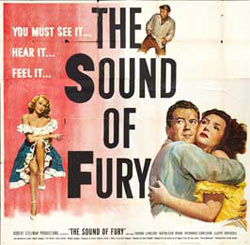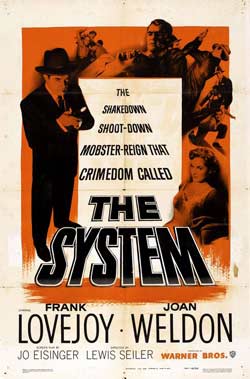Frank Lovejoy just had one of those faces. He looked like 1952. Reserved and calm, under most circumstances anyway, he was perfectly believable as a white collar working stiff—an insurance salesman or an honest cop. You could buy that he put in eight hours at the office, drove home to the suburbs, and settled down for the night with a scotch and soda with the missus. As one of his onscreen wives once told him, “I like the way you are: attractive and average.”
That line came from his best film, Nicholas Ray’s masterpiece In a Lonely Place, in which he plays Bogart’s suspicious cop buddy. It’s his best known role, but it’s only the peak of the crime films he made during the fifties. He starred opposite Peggie Castle in the entertaining Finger Man, and he made trash for the redbaiters with I Was a Communist for the FBI—the Reefer Madness of Commie subversion movies. In Ida Lupino’s brutal The Hitch-Hiker, he’s a good Samaritan who, along with his fishing buddy Edmond O’Brien, makes the disastrous mistake of giving a lift to a psychopath played by William Talman.
 His best performance is undoubtedly in Cy Enfield’s 1950 masterpiece The Sound of Fury as a struggling family man who becomes the wheel man for a stick-up artist played by Lloyd Bridges. When their petty crime spree turns into kidnapping and murder, Lovejoy is pulled into a hellish nightmare.
His best performance is undoubtedly in Cy Enfield’s 1950 masterpiece The Sound of Fury as a struggling family man who becomes the wheel man for a stick-up artist played by Lloyd Bridges. When their petty crime spree turns into kidnapping and murder, Lovejoy is pulled into a hellish nightmare.
Lovejoy had a gift that most actors would kill for—he was wholly believable as an ordinary man. At the same time, however, there is something boiling beneath the surface of this actor’s best work. His reserve didn’t indicate an absence of emotion, so much as feeling held in check. When he finally snaps at the end of The Sound of Fury, the effect is all the more powerful for having been wrung out of the actor. The Sound of Fury is an essential film of the 1950s, certainly on the short list of the best noirs, and one of the most underrated films in American cinema. It’s a vital, brilliant piece of art from a perpetually misunderstood era, and it owes a great deal of its success to Lovejoy’s brilliant central performance.
Born in the Bronx in 1912, Frank Lovejoy started out on the stage before making his way into radio in the thirties and forties. (Comic book geeks may be surprised to learn that Lovejoy was the voice of Blue Beetle on a radio series in the forties.) Throughout the forties and early fifties, he stayed busy in radio—where his flat baritone was put to good use in a variety of crime and mystery stories. By 1948, he headed out to Hollywood where he quickly made a name for himsel f as a dependable supporting player (he was the third name in the cast on a lot of movies behind people like Doris Day and Ronald Reagan), but he also established himself as a sturdy lead in noirs like 1953’s The System. He had the lead in Joseph H. Lewis’s underrated Korean war epic Retreat Hell! His last feature was the western Cole Younger, Gunfighter in 1958. By then, like many people, he’d made the move into television. He was the star of Meet McGraw (later rerun as The Adventures of McGraw) as a tough private detective with no first name, and he made appearances on a variety of programs throughout the fifties. He had returned to the stage in the early sixties, in a production of Gore Vidal’s The Best Man, when he died unexpectedly of a heart attack. He was only fifty years old.
f as a dependable supporting player (he was the third name in the cast on a lot of movies behind people like Doris Day and Ronald Reagan), but he also established himself as a sturdy lead in noirs like 1953’s The System. He had the lead in Joseph H. Lewis’s underrated Korean war epic Retreat Hell! His last feature was the western Cole Younger, Gunfighter in 1958. By then, like many people, he’d made the move into television. He was the star of Meet McGraw (later rerun as The Adventures of McGraw) as a tough private detective with no first name, and he made appearances on a variety of programs throughout the fifties. He had returned to the stage in the early sixties, in a production of Gore Vidal’s The Best Man, when he died unexpectedly of a heart attack. He was only fifty years old.
Lovejoy never became a big star, either on radio, stage, screen or television. His face and voice were as familiar and, in some sense as forgettable, as those you would have seen and heard everyday in the 1950s. Yet this forgotten man and his work are potent evocations of an important period in American history, an era too often dismissed with boilerplate nostalgia. The sunny fifties were, in fact, as paranoid, fraught, and confusing as any decade before or since. To understand this, read The Fifties by David Halberstam, or peruse the works of Jim Thompson or James Baldwin or the Beat poets. Or maybe just start with the films of Frank Lovejoy.
Jake Hinkson, The Night Editor, is the author of Hell on Church Street.
Read all posts by Jake Hinkson for Criminal Element.

I saw In a Lonely Place on TCM several years ago. I remember Gloria Grahame vividly. Bogart made a lot of good films in the late forties and early fifties. I also remember Frank Lovejoy. He was cool. I wonder if I can find a copy of The Sound of Fury? I’d like to see it. I like Lloyd Bridges too.
I saw In a Lonely Place on TCM several years ago. I remember Gloria Grahame vividly. Bogart made a lot of good films in the late forties and early fifties. I also remember Frank Lovejoy. He was cool. I wonder if I can find a copy of The Sound of Fury? I’d like to see it. I like Lloyd Bridges too.
Excellent piece, and I’ll be watching The Sound of Fury very soon. Thanks for the tip.